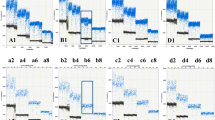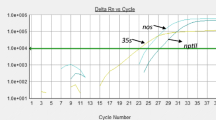Abstract
Since 2001, the traceability and labelling of genetically modified organism (GMO) food and feed derived products are obligatory in the European Union. Genetically modified organisms (GMO) are commonly detected via PCR tests. These tests typically involve several steps: (1) screening (2) construct specific (3) event specific and (4) reference gene. Screening tests are based on sequences frequently used for GM development, allowing for the detection of a large number of GMOs. To improve GMO detection efficiency, using specific multiplex master mixes, we developed two real-time PCR screening duplex PCR assays for the detection of P35S/Tnos and Pnos/T35S sequences. By combining these tests, we were able to reduce the time and cost of analysis. For the Pnos/T35S duplex, good sensitivity was obtained using one of the mixes compared to the others. Both duplexes had 100% specificity when tested on DNA from GM maize, rapeseed and soybean. When the duplexes were tested on DNA containing various amounts of GM maize and soybean, the corresponding targets were detected. The detection limit of our methods was found to be between 2 and 8 haploid genome copies for both P35S/Tnos and Pnos/T35S tests. In summary, with high efficiency and good linearity, the proposed two screening duplexes allow for more efficient GMO detection.


Similar content being viewed by others
References
Holst-Jensen A, Rønning SB, Løvseth A, Berdal KG (2003) PCR technology for screening and quantification of genetically modified organisms (GMOs). Anal Bioanal Chem 375:985–993
Van den Bulcke M, Lievens A, Barbau-Piednoir E, MbongoloMbella G, Roosens N, Sneyers M, Casi AL (2010) A theoretical introduction to “combinatory SYBRGreen qPCR screening”, a matrix-based approach for the detection of materials derived from genetically modified plants. Anal Bioanal Chem 396:2113–2123
Scholtens IM, Kok EJ, Hougs L, Molenaar B, Thissen JT, van der Voet H (2010) Increased efficacy for in-house validation of real-time PCR GMO detection methods. Anal Bioanal Chem 396:2213–2227
Feinberg M, Fernandez S, Cassard S, Bertheau Y (2005) Quantitation of 35S promoter in maize DNA extracts from genetically modified organisms using real-time polymerase chain reaction, part 2: interlaboratory study. J AOAC Int 88:558–573
Fernandez S, Charles-Delobel C, Geldreich A, Berthier G, Boyer F, Collonnier C, Coué-Philippe G, Diolez A, Duplan MN, Kebdani N, Romaniuk M, Feinberg M, Bertheau Y (2005) Quantification of the 35S promoter in DNA extracts from genetically modified organisms using real-time polymerase chain reaction and specificity assessment on various genetically modified organisms, part I: operating procedure. J AOAC Int 88:547–557
Reiting R, Broll H, Waiblinger HU, Grohmann L (2007) Collaborative study of a T-nos Real-Time PCR method for screening of genetically modified organisms in food products. J Verbr Lebensm 2:116–121
Matsuoka T, Kuribara H, Takubo K, Akiyama H, Miura H, Goda Y, Kusakabe Y, Isshiki K, Toyoda M, Hino A (2002) Detection of recombinant DNA segments introduced to genetically modified maize (Zea mays). J Agric Food Chem 50:2100–2109
James D, Schmidt AM, Wall E, Green M, Masri S (2003) Reliable detection and identification of genetically modified maize, soybean, and canola by multiplex PCR analysis. J Agric Food Chem 51:5829–5834
Germini A, Zanetti A, Salati C, Rossi S, Forre C, Schmid S, Marchelli R, Fogher C (2004) Development of a seven-target multiplex PCR for the simultaneous detection of transgenic soybean and maize in feeds and foods. J Agric Food Chem 52:3275–3280
Matsuoka T, Kuribara H, Akiyama H, Miura H, Goda Y, Kusakabe Y, Isshiki K, Toyoda M, Hino A (2001) A multiplex PCR method of detecting recombinant DNAs from five lines of genetically modified maize. J Food Hyg Soc Japan 42:24–32
Permingeat HR, Reggiardo MI, Vallejos RH (2002) Detection and quantification of transgenes in grains by multiplex and real-time PCR. J Agric Food Chem 50:4431–4436
Onishi M, Matsuoka T, Kodama T, Kashiwaba K, Futo S, Akiyama H, Maitani T, Furui S, Oguchi T, Hino A (2005) Development of a multiplex polymerase chain reaction method for simultaneous detection of eight events of genetically modified maize. J Agric Food Chem 53:9713–9721
Kobilinsky A, Bertheau Y (2005) Minimum cost acceptance sampling plans for grain control, with application to GMO detection. Chemom Intell Lab Syst 75:189–200
Oguchi T, Onishi M, Mano J, Akiyama H, Teshima R, Futo S, Furui S, Kitta K (2010) Development of multiplex PCR method for simultaneous detection of four events of genetically modified maize: DAS-59122–7, MIR604, MON863 and MON88017. Shokuhin Eiseigaku Zasshi 51:92–100
Bahrdt C, Krech AB, Wurz A, Wulff D (2010) Validation of a newly developed hexaplex real-time PCR assay for screening for présence of GMOs in food, feed and seed. Anal Bioanal Chem 96:2103–2112
Huang HY, Pan TM (2004) Detection of genetically modified maize MON810 and NK603 by multiplex and real-time polymerase chain reaction methods. J Agric Food Chem 52:3264–3268
Jiang L, Yang L, Rao J, Guo J, Wang S, Liu J, Lee S, Zhang D (2010) Development and in-house validation of the event-specific qualitative and quantitative PCR detection methods for genetically modified cotton MON15985. J Sci Food Agric 90:402–408
Waiblinger HU, Ernst B, Anderson A, Pietsch K (2008) Validation and collaborative study of a P35S and T-nos duplex real-time PCR screening method to detect genetically modified organism in food products. Eur Food Res Technol 226(5):1221–1228
Henegariu O, Heerema NA, Dlouhy SR, Vance GH, Vogt PH (1997) Multiplex PCR: critical parameters and step-by-step protocol. Biotechniques 23:504–511
Hein AE, Bodendorf U (2007) Real-time PCR: Duplexing without optimization. Anal Biochem 360:41–46
Chaouachi M, Fortabat MN, Geldreich A, Yot P, Kerlan C, Kebdani N, Audeon C, Romaniuk M, Bertheau Y (2008) An accurate real-time PCR test for the detection and quantification of cauliflower mosaïc virus (CaMV): applicable in GMO screening. Eur Food Res Technol 227(3):789–798
ISO/DIS/21571 (2004) Foodstuffs—Method of analysis for the detection of genetically modified organisms and derived products—Nucleic acid extraction. International Organization for Standardization, Geneva
Hernandez M, Rodriguez-Lazaro D, Esteve T, Prat S, Pla M (2003) Development of melting temperature-based SYBR Green I polymerase chain reaction methods for multiplex genetically modified organism detection. Anal Biochem 323:164–170
Yao Y, Nellaker C, Karlsson H (2006) Evaluation of minor groove binding probe and Taqman probe PCR assays: Influence of mismatches and template complexity on quantification. Mol Cell Probes 20:311–316
Sohni Y, Kanjilal S, Kapur V (2008) Performance evaluation of five commercial real-time PCR reagent systems using TaqMan assays for B. anthracis detection. Clin Biochem 41:640–644
Cankar K, Stebih D, Dreo T, Zel J, Gruden K (2006) Critical points of DNA quantification by real-time PCR—effects of DNA extraction method and sample matrix on quantification of genetically modified organisms. BMC Biotechnol 6:37–52
Acknowledgments
The authors would like to thank Direction Générale de la Consommation, de la Concurrence et de la Répression des Fraudes (DGCCRF) and Direction Générale de l'Alimentation (DGAl) for kindly providing us with samples. This work was financially supported by the European Commission through the Sixth Framework Program, integrated project Co-Extra http://www.coextra.eu; contract FOOD-2005-CT-007158). This is gratefully acknowledged. The authors thank Dr Y. Roussel for critical reading of the manuscript.
Author information
Authors and Affiliations
Corresponding authors
Rights and permissions
About this article
Cite this article
Pansiot, J., Chaouachi, M., Cavellini, L. et al. Development of two screening duplex PCR assays for genetically modified organism quantification using multiplex real-time PCR master mixes. Eur Food Res Technol 232, 327–334 (2011). https://doi.org/10.1007/s00217-010-1394-4
Received:
Revised:
Accepted:
Published:
Issue Date:
DOI: https://doi.org/10.1007/s00217-010-1394-4




